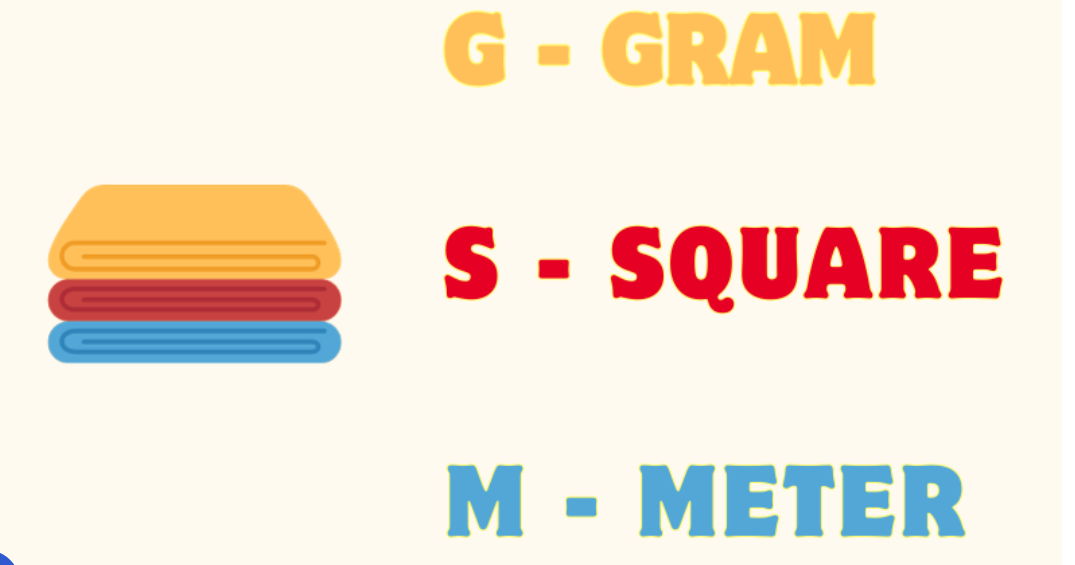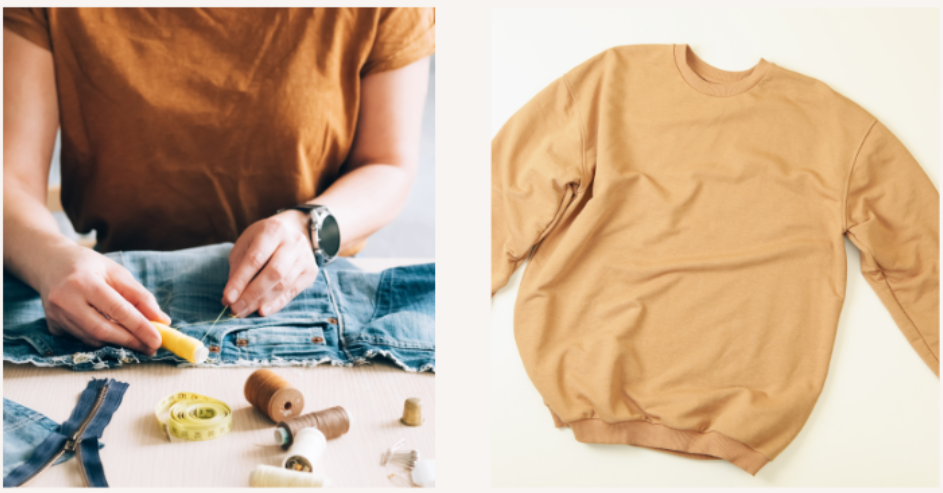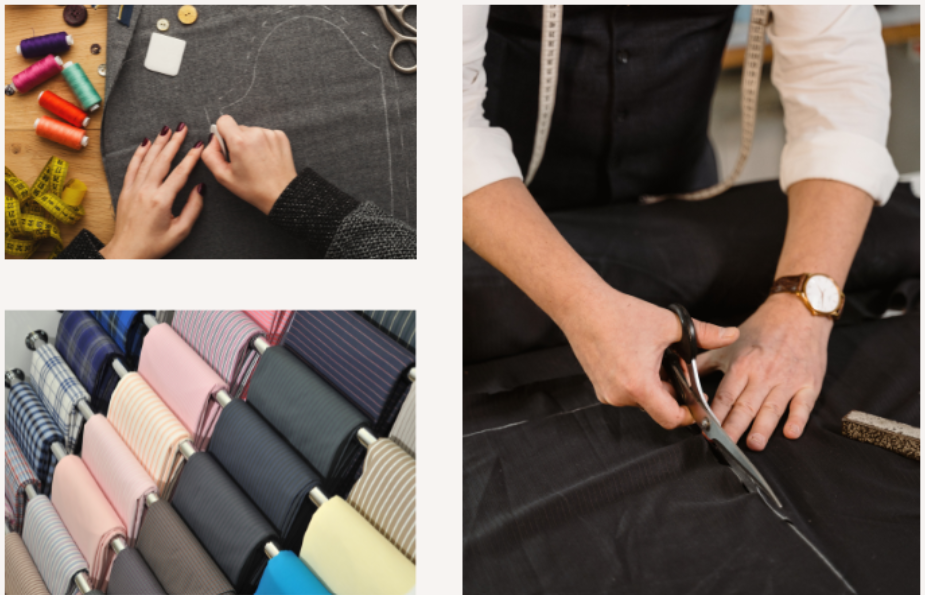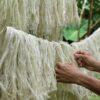Understanding GSM in Fabrics: What Does GSM in T-shirts Mean?
When you delve into the world of clothing and textiles, you’ll inevitably come across the term “GSM” concerning fabrics, particularly in the context of T-shirts. So, what exactly is GSM in fabrics, and why does it matter? In this comprehensive guide, Coolmate will provide you with all the information you need to understand fabric GSM and its significance in the world of fashion and textiles.
I. Demystifying Fabric GSM: A Deeper Look
1. Defining Fabric GSM
Fabric GSM, short for “Grams per Square Meter,” is a standardized measurement used to quantify the weight of fabric per unit area. This unit of measurement helps determine the density, thickness, durability, softness, and absorbency of a fabric. Furthermore, GSM plays a pivotal role in assessing the value and quality of the fabric.

The concept of GSM is ubiquitous in the textile industry and is commonly used to describe the weight of fabric across different categories of clothing. For example, you might encounter a Coolmate T-shirt with a fabric GSM of 200, indicating that it weighs 200 grams per square meter.
2. Key Aspects of Fabric GSM
Now that we have established what fabric GSM means, it’s essential to recognize that fabrics or clothing items with the same GSM measurement may not necessarily share identical qualities. Here are some key considerations:
- GSM Measures Weight, Not Quality: While GSM provides valuable information about a fabric’s weight, it does not convey the entire story. Factors such as tensile strength, elasticity, fineness of fibers, and the fabric’s weaving or knitting pattern also contribute to its quality.
- Quality Varies by Material: Fabric quality is intrinsically linked to the type of material used. Even if two fabrics share the same GSM measurement, their quality can differ significantly based on the choice of fibers. For instance, a fabric made of long-fibered wool will often be thicker, softer, and more luxurious compared to one crafted from coarse, short-fibered cotton.
- Higher GSM Indicates Thickness: Generally, a higher GSM signifies a denser and thicker fabric, assuming that you are comparing fabrics of the same type. This information is particularly valuable when selecting clothing for different seasons, as higher GSM fabrics tend to provide more warmth and are suitable for colder weather.
- Minor Variations Are Possible: It’s important to note that there can be minor variations in GSM measurements due to factors like moisture content. However, these discrepancies are typically negligible and fall within an acceptable range.
- Specific to Each Fabric Type: GSM measurements are specific to individual fabric types. What may be considered a high GSM for one fabric could be standard for another. Therefore, it’s crucial to consider the context and intended use of the fabric when evaluating its GSM.

3. Common Units of Fabric Measurement
Fabric GSM is just one of several units used to measure fabric weight. Here are some commonly used units:
- Grams per Square Meter (g/m²): This is the most prevalent unit for measuring fabric GSM. It quantifies the weight of the fabric in grams per square meter of surface area, providing a global standard for fabric GSM measurement.
- Grams per Yard (g/yd²): Grams per yard measures fabric weight in grams across a one-yard length, which is approximately 0.91 meters. This unit is more commonly used in manufacturing and industrial settings.
- Ounces per Square Yard (oz/yd²): Similar to GSM, ounces per square yard is a unit that measures fabric weight in ounces per square yard. This unit is more commonly used in the United Kingdom and some other regions.

GSM in fabrics is a vital metric that aids consumers, designers, and manufacturers in understanding the weight and, to some extent, the thickness of a fabric. However, it is essential to remember that GSM alone does not provide a comprehensive assessment of a fabric’s overall quality, durability, texture, or performance characteristics. To make well-informed decisions about fabrics, consider a holistic approach that takes into account additional factors, including the choice of materials, fiber properties, and the intended application of the fabric
II. Why Fabric GSM Matters: Understanding Its Significance
In the world of textiles, Fabric GSM, or Grams per Square Meter, serves as a fundamental metric that carries significant implications for manufacturers, designers, and consumers alike. It plays a pivotal role in fabric selection, product quality assessment, and cost estimation. In this comprehensive guide, we will delve deeper into the multifaceted reasons why measuring Fabric GSM is essential across various aspects of the textile industry and consumer decision-making.
1. Comparing and Selecting Suitable Fabrics
One of the foremost applications of measuring Fabric GSM is to facilitate the evaluation and comparison of fabrics, aiding in the selection of the most suitable material for specific needs and purposes. The Grams per Square Meter metric encapsulates essential characteristics such as thickness, weight, softness, and absorbency, all of which exert a profound influence on comfort, durability, and aesthetic appeal.

Fabrics boasting a lower GSM value (typically below 150 GSM) are renowned for their lightweight, breathable, soft, and airy properties. These fabrics are the preferred choice for crafting a plethora of summer apparel, including T-shirts, sundresses, shorts, and other warm-weather clothing items. Their lightweight and breathable nature ensure optimal comfort for wearers during hot and humid conditions.
Conversely, fabrics with medium GSM values (ranging from 150 to 350 GSM) strike an equilibrium between thickness, durability, and absorbency. This class of fabrics is eminently suitable for creating a diverse range of items such as sweaters, jackets, jeans, trousers, and clothing designed for the fall and winter seasons. They provide both warmth and comfort, making them versatile choices for cooler climates.
For those seeking warmth and insulation against the cold, fabrics with high GSM values (exceeding 350 GSM) offer a robust solution. These fabrics are characterized by their substantial thickness, considerable weight, sturdiness, and superior heat-retaining properties. They find their niche in the creation of winter essentials like woolen coats, leather jackets, blankets, and cold-weather attire.
2. Assessing Fabric Quality and Durability
Fabric GSM serves as an essential yardstick for evaluating fabric quality and durability. However, it’s essential to recognize that a high GSM value alone does not guarantee top-tier fabric quality. The overall quality of a fabric hinges on an amalgamation of factors, including the type of fiber employed, weaving or knitting techniques, and the various treatments and finishes it undergoes. Nevertheless, fabrics with excessively low or high GSM values can have detrimental effects on quality and durability.

Fabrics with extremely low GSM values may exhibit vulnerability to tearing, pilling, color fading, and excessive shrinkage during laundering. Conversely, fabrics characterized by excessively high GSM values can become rigid, unwieldy, challenging to launder and dry, thereby causing discomfort to the wearer. Therefore, measuring Fabric GSM stands as a crucial step for both manufacturers and consumers, enabling them to scrutinize and regulate fabric quality and durability effectively.
3. Estimating Fabric Cost and Profitability
Fabric GSM carries immense weight in the determination of fabric cost and profitability. Fabrics boasting higher GSM values often command a higher price tag than their lower GSM counterparts due to the increased consumption of raw materials, labor, and production time. However, it is imperative to underscore that fabric pricing is influenced by a myriad of factors, encompassing the type of fiber (e.g., cotton, wool, polyester), manufacturing processes, source of origin, rarity, and, most significantly, fabric quality.

In certain scenarios, fabrics with lower GSM values may paradoxically exhibit higher price points. For instance, premium fabrics such as satin and silk may possess lower GSM values but are characterized by elevated prices due to the exceptional properties of their fibers and the intricate production processes they undergo. Consequently, fabric pricing cannot be ascribed exclusively to GSM; it necessitates a holistic evaluation of numerous factors to glean a comprehensive understanding of the cost and quality associated with a particular fabric product.
4. Complying with Standards and Regulations
Measuring Fabric GSM assumes paramount importance in the context of adhering to established standards and regulations within the textile industry. Additionally, it provides consumers with vital information that empowers them to comprehend the thickness and quality of the products they intend to purchase.

Furthermore, adherence to standards and regulations governing Fabric GSM aids in the efficient management of raw materials and facilitates precise cost forecasts. Manufacturers benefit from the ability to accurately calculate the requisite fabric quantities for specific products, thereby enhancing cost-efficiency and resource allocation.
III. Standard Formula for Calculating Fabric GSM
1. The Formula for Calculating Fabric GSM
Fabric GSM, or grams per square meter, is a crucial metric for assessing the weight and thickness of textiles. To compute the Fabric GSM, two fundamental parameters must be determined: fabric width and fabric weight.
- Fabric width represents the length and breadth of the fabric and is typically measured in meters. For instance, if a piece of fabric measures 2 meters in length and 1 meter in width, its fabric width is 2 meters.
- Fabric weight is the number of meters of fabric per kilogram, measured in meters per kilogram (m/kg).
The general formula for calculating Fabric GSM is:
GSM = 1000 / (Fabric Width x Fabric Weight)
Let’s illustrate this with an example: Suppose you have a piece of fabric with a length of 2 meters, a width of 1 meter, and a fabric weight of 2.75 m/kg. To calculate its GSM, use the formula as follows:
GSM = 1000 / (2 x 1 x 2.75) = 200 gsm
2. Calculating Fabric GSM Using Tools
Beyond manual calculations, specialized tools are available to measure Fabric GSM accurately. Textile mills and large fabric companies commonly utilize instruments such as fabric cutters and precision scales for GSM measurements.
- Fabric cutters consist of cutting blades and a rotating spindle that create circular fabric samples with an area of 100 cm2. Beneath the fabric cutter, there is typically a rubber base to secure the fabric sample and ensure precise measurements.
Once the fabric sample is cut, its weight is measured using a precision scale. These electronic scales offer high precision and are frequently employed in textile factories.
IV. Is Fabric GSM the Sole Indicator of Fabric Quality?
The answer is both yes and no. While Fabric GSM serves as a valuable criterion for evaluating fabric quality, it does not stand alone as the sole determinant, as fabric quality hinges on multiple interrelated factors.
Fabric GSM measures the weight of fabric per square meter, providing insights into thickness, softness, and, to some extent, durability. However, fabric quality is influenced by more than just GSM. Factors such as the type of fabric fiber, weaving techniques, production methods, durability, elasticity, water resistance, fiber structure, and fabric processing (including dyeing and wrinkle resistance) all play pivotal roles in determining the overall quality of fabric.
A fabric with a high GSM may indeed convey a sense of superior thickness and may be perceived as higher quality than a lower GSM fabric. Nevertheless, a high GSM fabric does not automatically equate to better quality if other essential aspects, such as fiber type or production processes, fall short of quality standards.

V. Additional Factors Influencing Fabric Quality
While Fabric GSM is a fundamental metric in assessing fabric quality, it’s essential to recognize that fabric quality depends on several interconnected factors. Here are some additional elements that contribute to fabric quality:
- Fiber Type: The type of fiber used in fabric production significantly impacts its quality. Natural fibers like cotton, silk, and wool are often prized for their comfort and breathability. Synthetic fibers such as polyester, nylon, and acrylic are valued for their durability and resistance to wrinkles and moisture. The choice of fiber depends on the intended use of the fabric.
- Weaving Techniques: The method of weaving or knitting the fabric plays a crucial role in its quality. Different weaving patterns and techniques can result in varying levels of breathability, flexibility, and durability. Common weaving patterns include plain weave, twill weave, and satin weave, each with its unique characteristics.
- Production Methods: How the fabric is manufactured can significantly affect its quality. Factors such as the tension during weaving, dyeing processes, and finishing treatments (e.g., mercerization or enzyme washing) can enhance or detract from the fabric’s overall quality.
- Durability: Fabric durability is crucial, especially for items subjected to frequent wear and laundering. The fabric’s ability to withstand wear and tear, resist pilling, and maintain colorfastness is a key determinant of its quality.
- Elasticity: Depending on the intended use, some fabrics require elasticity or stretch. Fabrics like spandex or elastane blends offer elasticity, making them suitable for activewear and fitted garments.
- Water Resistance: Fabrics used for outdoor or sportswear often need water-resistant properties. Specialized treatments or coatings can enhance a fabric’s ability to repel water, keeping the wearer dry.
- Fiber Structure: The structure of the individual fibers in a fabric can influence its texture, softness, and breathability. Fine, long fibers often result in a smoother and softer fabric, while shorter, coarser fibers can yield a coarser texture.
- Fabric Processing: Processes such as dyeing, printing, and wrinkle resistance treatments can affect the fabric’s appearance and performance. High-quality dyeing techniques ensure vibrant, long-lasting colors, while wrinkle-resistant treatments reduce the need for ironing.
- Environmental Considerations: Increasingly, consumers and manufacturers are considering sustainability and environmental impact when evaluating fabric quality. Sustainable practices in fiber production, dyeing, and waste reduction contribute positively to fabric quality in the eyes of environmentally conscious consumers.
- Comfort and Feel: The comfort and tactile feel of a fabric are subjective but essential aspects of quality. Fabrics should be pleasant to wear against the skin and provide the desired level of comfort for their intended use.
In conclusion, fabric quality is a multifaceted concept that encompasses a range of attributes beyond Fabric GSM. While GSM indicates thickness and weight, it does not account for all the factors that determine fabric quality. A comprehensive evaluation of fabric quality considers fiber type, weaving techniques, production methods, durability, elasticity, water resistance, fiber structure, fabric processing, and environmental considerations. Assessing these elements collectively ensures a more accurate judgment of fabric quality and its suitability for specific applications.


